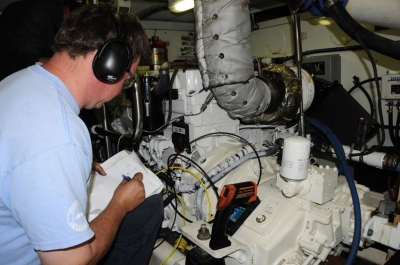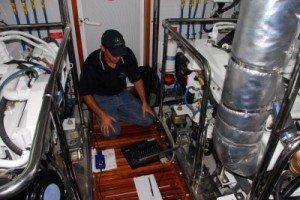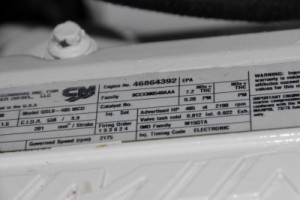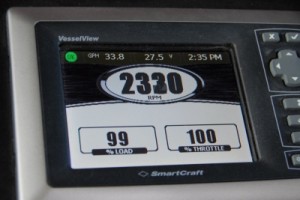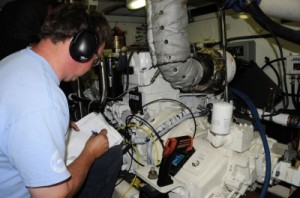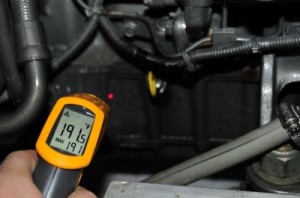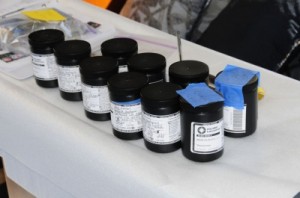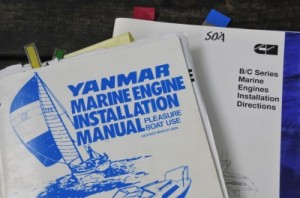Text and photos by Steve D’Antonio
Copyright 2013
Skilled, experienced technicians understand what they need to do, and they have the right tools and know how to use them, in order to ensure an engine is in proper working order.
In the past year I’ve carried out scores of sea trials. The bulk of these were associated with pre-purchase inspections, while others were to diagnose and troubleshoot problems or evaluate completed repairs, and still others were designed to evaluate vessels for existing owners, while teaching them about propulsion system operation and maintenance.
In many of these cases, a professional mechanic or mechanics accompanied the vessel in order to monitor the propulsion system and its operating characteristics, often using special tools and equipment such as manometers, pressure and vacuum gauges and pyrometers. Regrettably, however, in the vast majority of these cases, these professionals failed to fulfill the duties for which they were hired and often well-compensated.
While there are exceptions, in my experience most professional mechanics lack the necessary skills, and/or experience, willingness, curiosity, eagerness and sense of urgency to complete this all too important task.
Here’s an example, I recently completed a pre-purchase inspection aboard a 50-foot vessel, which included an extended sea trial; it was attended by an experienced, professional mechanic who specialized in such engine surveys. The vessel was over ten years old and had its share of maladies, my inspection list numbered over 125 entries, twenty-six of which related to the engine and generator alone, some of which were critical, including an improperly supported and overheating exhaust system and incorrectly secured shift and throttle cables. Yet, on several occasions the mechanic pronounced the engine and engine room as “fine, it’s all good”, offering just a handful of suggestions.
On the second day of my inspection I removed the dipstick from the transmission and found it dry, the oil level was too low to register. When this was brought to the attention of the mechanic he admitted he had not checked the level before the sea trial began. The response was disappointing and demonstrated poor attention to detail for even the most basic observations.
To reiterate, there are exceptions, savvy, smart, dedicated and professional mechanics are out there, however, they are just that, exceptions. Therefore, as the buyer or boat owner, you must beware of these shortcomings and be prepared to guard against them.
Engine Inspections
Anyone who has read my articles or attended my lectures will recall that I’m a strong advocate of the pre-purchase survey for used as well as new vessels. Insurance companies and lending institutions nearly always require a survey in order to secure a loan or insurance for a used vessel. It’s understandable; these entities need to be confident about the condition of the vessel for which they are providing their respective services.
Why, however, you might ask, would a survey be required for a new vessel? Regrettably, custom and production new boat builders, even the best ones, make mistakes, more often than not honest ones, mistakes you, as the buyer, certainly want to know about before signing on the dotted line.
Alerted to these building errors, defects, faults or simple oversights aboard any vessel, new or used, you are in the enviable position of being able to negotiate for their correction, or compensation, before steaming away from the builder’s or broker’s docks. In my experience reputable builders and brokers want to know about these problems during the sale process as well, rather than dealing with them when the vessel is off cruising, possibly thousands of miles away.
As a former boat yard manager and now marine consultant, I’ve been involved, both directly and indirectly, in many vessel acquisitions and sales. I’m often surprised at how many times a buyer will complete, or consider completing, a sale without having the engine and generator carefully inspected and tested by a trained mechanic, as part of the pre-purchase survey or inspection (as a point of clarification, surveyors carry out surveys, I conduct pre-purchase inspections). Nearly all surveyors are quick to make it clear in their reports, and rightfully so, that the survey excludes all but the most cursory of inspections of engines and generators. Some will record serial and model numbers; others will go so far as to test wide open throttle (WOT) readings and fully load the generator and include these results in their written report.
Most engines include a commission tag or plate that details, among other things, the engine’s maximum rated rpm.
Few if any, however, will carry out the type of thorough, detailed testing of an engine installation that will offer meaningful information for the buyer (information that often comes as a revelation to the seller or builder), information that may spell potentially costly reliability, efficiency or longevity trouble down the boat ownership road. It’s worth reiterating that many of the following engine analyses apply, just like surveys, to used as well as new vessels.
The Engine Survey
As previously mentioned, even a cursory engine survey, one that requires no special tools, instruments or equipment (you can therefore carry out this test yourself), should include, provided the engine is in good working order, a WOT run to confirm several performance parameters.
Initially, it may confirm that the engine and propeller are properly matched. Additionally, the WOT run will also confirm that the engine is capable of producing maximum rpm for a sustained period of time without overheating, starving for fuel or air or experiencing other problems such as smoking or vibration. How long should the engine be operated in this manner to carry out the tests? My preference is to perform a WOT run for between five and ten minutes, and then back down to cruising rpm, typically 80% of load or WOT, for an additional 30 minutes.
If the seller, broker or builder is reluctant to operate the engine(s) under these conditions without good reason (if the engine is in poor condition and has serious defects, then such a test is not appropriate; and the purchase may, as a result, be reevaluated), then he or she is either uninformed or has some concern about its ability to perform, which in turn should raise your level of awareness and concern.
A clean bill of health, this electronically controlled engine offers a wealth of valuable information in its display, and the news here is all good. The engines reaches its WOT (and just a little more, which is desirable) at 100% throttle and 99% load. Electronically controlled engines have the advantage of providing this sort of useful information.
Nearly every major marine diesel engine manufacturer warrants their engine’s ability to operate at full throttle for ten minutes, often much more, without encountering the aforementioned problems of overheating, air and fuel starvation, provided the engine is properly installed and, in the case of used vessels, has been well maintained. Before conducting your own engine survey, fore arm yourself with a copy of the specifications for the exact engine model you’ll be running, including its duty or “M” rating (the M rating is a measure of an engine’s ability to operate for a given duration at WOT as well as its presumed seasonal use, they range from M1 through M5). These specifications will also include, among many other things, the WOT rpm, proper coolant temperature and oil pressure. If, during the sea trial the engine fails to meet any of the prescribed parameters, the cause may be as simple as a fouled propeller or as complex as excessive back pressure, a fuel restriction, air inlet restriction or shaft misalignment.
Time to Call in a Professional
A trained, experienced, motivated and conscientious professional mechanic will be able to offer a buyer the greatest insight into the condition of the vessel’s engine and generator. His or her analysis and testing, however, typically begins long before getting under way. While the engine and generator are still cold, he should carry out a thorough visual inspection of the installation, carefully comparing it to the requirements set forth by the engine and generator manufacturer. During this inspection he should confirm, among other things, that the exhaust system is arranged in such a way as to preclude any chance of water flowing back up into the engine’s cylinders (one of the more common engine installation faults), typically a function of the exhaust down-angle; that the cable used for the engine starter is of the correct gauge and that the motor mounts are tight and not over extended.
Skilled pros should know what tasks need to be performed during and engine inspection, as well as bringing the necessary tools and engine specifications, and their own checklist.
He would then run the engine briefly to warm it, shut it down and removed all of the injectors in order to perform a differential leak-down or compression test of each cylinder (compression/leak-down tests are advisable on all but new engines, however, this is considered “invasive”; most sellers will not agree to this level of disassembly for a pre-purchase survey). Alternatively, a crankcase pressure test, which is non-invasive, could be performed, and the results it yields, whine not as definitive as compression/leak-down tests, are never the less very valuable. All three of these tests evaluate the ability of the piston rings to make a good seal with cylinder walls; if this seal is compromised, for what ever reason, the fix is nearly always costly, so at least one of these tests should be performed. For pre-purchase evaluations the crankcase pressure test is the most common.
Once these tests are completed, he would then attach a variety of gauges and meters as well as, where electronically controlled engines are concerned, a laptop computer (this interfaces with and gleans information from the engine’s electronic control and management computer) to the engine that will, while underway, measure everything from exhaust gas temperature and pressure to load, throttle position, fuel and turbo boost pressure. In addition to these tests, he would also measure engine room temperature (most engine manufacturers include a maximum allowable difference in temperature, or delta T, between the engine air inlet, measured at the air filter, and the outside air, that is usually no more than 30°F) as well as the temperature of the exterior of the exhaust system, both wet and dry, in several locations. ABYC’s voluntary guidelines, and those of many engine manufacturers, “require” that no portion of the exposed exhaust system exceed 200°F.
The infrared pyrometer, when used properly, can provide a wealth of information. In this case it’s confirming that the oil temperature is correct while under load. As useful as they are, pyrometers can be, and often are, used incorrectly.
It’s vitally important, while the underway portion of the engine analysis is being carried out, that the vessel is arranged in its normal operating condition, i.e. all hatches and access ports to the engine compartment must be closed. I’ve been aboard numerous vessels during engine surveys and never cease to be amazed when a mechanic sets up his or her instruments and laptop in the relative comfort of the air conditioned cabin, with wires and hoses leading through an open hatch or door into the engine room. Make no mistake about it; this practice thoroughly invalidates several parameters of the testing, including engine air inlet delta T and engine room “depression”, or the potential vacuum created within an engine room by an engine when an insufficient cross section of intake vent surface area exists, along with dB or sound level analysis. Most engine manufacturers clearly specify the number of square inches required for each engine model (don’t forget the generator in the calculation), to ensure proper air supply.
Fluid Analysis
The final step in the engine survey process involves drawing samples of engine and generator crankcase oil and coolant as well as transmission fluid for laboratory analysis. Fluid and oil analysis, when sampled properly and analyzed by those with the skills and experience to do so, is the mechanic’s and boat buyer’s crystal ball. It can alert you to a variety of engine maladies ranging from worn out bearings to leaking head gasket and everything in between, often long before any visible signs are apparent even to an experienced mechanic. In my experience, the fluid analysis offered by engine manufacturers (and consequently by their dealers) is adequate although far from easy to understand and often less than thorough. My preference is for independent laboratories whose analysis is completely impartial. In many cases, because they are frequently relied upon by users rather than professionals, their reports are also far easier to interpret, most include a synopsis and if necessary you can call the lab for further elaboration, a feature that is likely not available to you when manufacturer’s own labs are used.
Additionally, choosing your own lab and providing sampling kits and pumps to the mechanic carrying out the engine service, who then returns them to you for shipment to the lab, maintains your “chain of custody”, you know they have been sent and that the results are for your fluids and they are returned directly to you. Perhaps the most valuable aspect of utilizing your own lab is the expediency and reporting method. Most commercial fluid analysis labs will e mail youresults within 48 hrs of receiving a sample.
Fluid analysis is a key element in any engine survey.
A final caveat where fluid analysis is concerned; proper fluid extraction technique must be used (many labs offer instructions on their website). Among other things, when samples are drawn it’s critically important that cross contamination be avoided. Using the same tube to draw oil or coolant from multiple engines or transmissions is strictly prohibited. Most labs sell inexpensive fluid analysis kits as well as vacuum pumps (separate for oil and coolant) and rolls of one time use disposable pick up tubing. The same tube, even if blown out, drained or otherwise cleaned must never be used more than once because of the risk of introducing contaminants from one sample to another, thereby insidiously invalidating the results. I’ve observed mechanics commit this tech sin on several occasions during engine inspections and have had to insist on re-sampling.
If you are planning to purchase a vessel a thorough inspection of the engine and generator installation is a virtual necessity. Without it you simply have no way of knowing the condition of these expensive components. More importantly, a cursory or incomplete inspection has but one thing to offer; a false sense of security, and one for which you’ve paid.
What to Ask For
When arranging an engine survey, there are a few key details that those carrying out the process should agree to readily.
- A sea trial. The engine (and to an extent the generator) should be inspected and analyzed while underway at various rpm, including WOT or full load.
- For mechanically governed engines, a strobe tachometer should be used to verify rpm.
- Monitor exhaust system back pressure test and exhaust gas temperature.
- Compression test for engines with over 2000 hrs. or those that have been rebuilt or undergone major repairs or are otherwise suspect. Alternatively, a crankcase pressure test could be carried out.
- For electronically controlled engines, the electronic control unit should be accessed with a laptop and appropriate program. This will read a variety of factors and fault codes.
- Take fluid samples from the engine and generator crankcase and coolant expansion tank (coolant samples should be taken from the expansion tank and not the recovery bottle), transmission and PTO-powered hydraulic system if equipped. It’s critically important that all available fluid data be supplied to the lab, especially lube and unit time and type/weight. In so many cases this information is not included, potentially invalidating the results.
- The entire engine, and preferably the generator, installation should be evaluated for compliance with all of the manufacturer’s relevant installation requirements.
- Finally, you should receive a detailed, written report that includes an interpretation of its contents and a synopsis. In so many cases I see clients handed a few sheets of paper with groups of numbers that are unintelligible to anyone other than the technician. That’s simply not acceptable.
Engine and generator installations should be evaluated to ensure that they comply with the requirements of their manufacturers. Failure to do so could void a warranty, as well as creating potentially costly reliability and safety issues.
This means the person carrying out the survey must have more than a passing knowledge of these requirements, and ideally he or she must have access to the full installation instructions. Fully 75% of the engines and generators I inspect fail to meet these requirements, and in many cases these oversights occurred during the vessel’s construction.
For more information on the services provided by Steve D’Antonio Marine Consulting, Inc. please e mail Steve at info@stevedmarineconsulting.com
or call 804-776-0981

